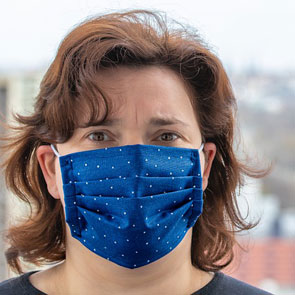4 Tips to Prevent and Treat Maskne
 During the COVID-19 pandemic, face masks have become the new normal because they play an essential role in reducing the spread of the novel coronavirus. Unfortunately, they can result in skin problems, such as dryness, irritation, and breakouts that have been nicknamed “maskne” (mask + acne). Since not wearing a mask isn’t an option, you may need some tips on how to prevent maskne and keep your skin healthy under the mask.
During the COVID-19 pandemic, face masks have become the new normal because they play an essential role in reducing the spread of the novel coronavirus. Unfortunately, they can result in skin problems, such as dryness, irritation, and breakouts that have been nicknamed “maskne” (mask + acne). Since not wearing a mask isn’t an option, you may need some tips on how to prevent maskne and keep your skin healthy under the mask.First of all, lets figure out why maskne happens in the first place. When you exhale, some of the moisture in your breath condenses under the mask, creating a good environment for bacterial growth. Sebum and dead skin cells that get trapped under the mask contribute to this environment and clog pores. This results in pimples and inflammation associated with acne. Luckily, there are a few steps you can take to reduce the risk of maskne.
Choose the Right Mask and Take Care of It
Ideally, you should wear a disposable mask and change it every couple of hours, but this is probably impossible for several reasons (this will cost you quite a lot of money, doctors and nurses need disposable masks more, disposable masks pollute the environment, etc.). That is why it is important to choose the right reusable mask and care for it well.
A 100% cotton mask will let your skin breathe, reducing condensation; synthetic masks, on the other hand, are more likely to cause irritation. However, skin oil and dirt will build up over time even when you’re wearing a soft, breathable mask, so you should change your mask every few hours. Wash used masks in hot water with a fragrance-free, hypoallergenic detergent and iron them on the inside before putting them on. You should also make sure that your mask isn’t too tight, otherwise it may cause skin irritation and chafing.
Check this out: 5 Tips for Treating and Preventing Skin Irritation Caused by Wearing Face Masks
Cleanse and Moisturize Your Face Religiously
Cleansing and moisturizing have always been an important part of any skincare routine, but they are even more important if you have to wear a face mask for hours. You should wash your face with a mild cleanser at least twice a day, in the morning and in the evening, and use a lightweight, oil-free moisturizer with ceramides or hyaluronic acid immediately after. If you have oily or problem skin, do your best to avoid heavily textured products to prevent clogged pores.
Ideally, you should also wash your face when you change your mask, but if this is impossible, you should at least use blotting paper to absorb some of the oil from the skin surface.
Check this out: 5 Ingredients to Avoid in Moisturizers
Ditch Makeup
Wearing makeup under your mask is not the best idea, because it will increase the amount of buildup and, therefore, the risk of maskne. If makeup is absolutely necessary, ditch heavy foundation in favor of BB cream or tinted moisturizer and use only products that are labeled “non-comedogenic”.
Check this out: 6 Tips for Wearing Makeup with a Face Mask
Use Anti-Acne Products Carefully
If you already have maskne, you’re probably considering using anti-acne products to make it go away. While this is definitely the right line of thinking, you should proceed with caution because certain anti-acne ingredients in high concentrations can weaken your skin’s barrier function and make things worse. Start with over-the-counter products that have a low concentration of active ingredients (such as zinc or salicylic acid). If they don’t help, consult a dermatologist before trying anything stronger.
Check this out: How to Take Care of Sensitive, Acne-Prone Skin
Breadcrumbs
Filters
- Face
Tags
Related Articles
- How to Make Your Own Hand Sanitizer, 6 Quarantine Beauty Tips, 5 Post-Quarantine Beauty Resolutions to Consider, 4 Tips for Taking Care of Your Lips During Quarantine